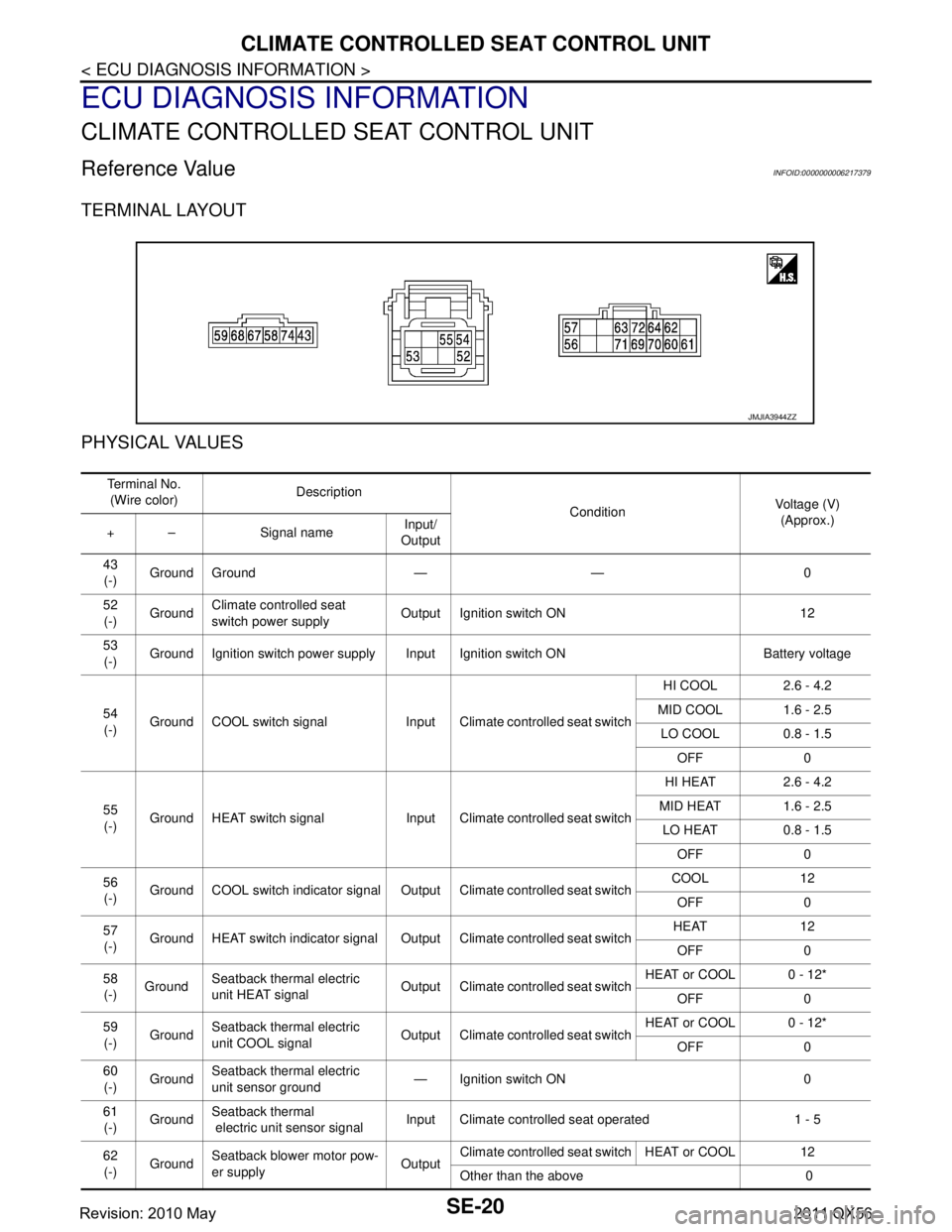2011 INFINITI QX56 sensor
[x] Cancel search: sensorPage 4458 of 5598
![INFINITI QX56 2011 Factory Service Manual
SCS-98
< REMOVAL AND INSTALLATION >[AIR LEVELIZER CONTROL SYSTEM]
VEHICLE HEIGHT SENSOR
VEHICLE HEIGHT SENSOR
Exploded ViewINFOID:0000000006256104
Removal and InstallationINFOID:0000000006256105
REMO INFINITI QX56 2011 Factory Service Manual
SCS-98
< REMOVAL AND INSTALLATION >[AIR LEVELIZER CONTROL SYSTEM]
VEHICLE HEIGHT SENSOR
VEHICLE HEIGHT SENSOR
Exploded ViewINFOID:0000000006256104
Removal and InstallationINFOID:0000000006256105
REMO](/manual-img/42/57033/w960_57033-4457.png)
SCS-98
< REMOVAL AND INSTALLATION >[AIR LEVELIZER CONTROL SYSTEM]
VEHICLE HEIGHT SENSOR
VEHICLE HEIGHT SENSOR
Exploded ViewINFOID:0000000006256104
Removal and InstallationINFOID:0000000006256105
REMOVAL
CAUTION:
Never disassemble the vehicle height sensor.
1. Lift up the vehicle.
2. Disconnect the vehicle height sensor harness connector.
3. Remove the vehicle height sensor.
INSTALLATION
Note the following, and install in the reverse order of the removal.
Completely engage hooks on frame when installing vehicle height
sensor.
1. Vehicle height sensor
:Vehicle front
Refer to GI-4, "
Components" for symbols not described on the above.
JSEIA0226GB
JSEIA0243ZZ
Revision: 2010 May2011 QX56
Page 4459 of 5598
![INFINITI QX56 2011 Factory Service Manual
VEHICLE HEIGHT SENSORSCS-99
< REMOVAL AND INSTALLATION > [AIR LEVELIZER CONTROL SYSTEM]
C
D
F
G H
I
J
K L
M A
B
SCS
N
O P
AdjustmentINFOID:0000000006256106
After vehicle height sensor is replaced, re INFINITI QX56 2011 Factory Service Manual
VEHICLE HEIGHT SENSORSCS-99
< REMOVAL AND INSTALLATION > [AIR LEVELIZER CONTROL SYSTEM]
C
D
F
G H
I
J
K L
M A
B
SCS
N
O P
AdjustmentINFOID:0000000006256106
After vehicle height sensor is replaced, re](/manual-img/42/57033/w960_57033-4458.png)
VEHICLE HEIGHT SENSORSCS-99
< REMOVAL AND INSTALLATION > [AIR LEVELIZER CONTROL SYSTEM]
C
D
F
G H
I
J
K L
M A
B
SCS
N
O P
AdjustmentINFOID:0000000006256106
After vehicle height sensor is replaced, removal or installation, perform “STANDARD VEHICLE HEIGHT SET-
TING”. Refer to SCS-67, "
Work Procedure".
Revision: 2010 May2011 QX56
Page 4461 of 5598

SE-2
SECOND HEATED SEAT SYSTEM : System De-
scription ..................................................................
16
CLIMATE CONTROLLED SEAT SYSTEM ........... ...17
CLIMATE CONTROLLED SEAT SYSTEM : Sys-
tem Diagram ........................................................ ...
17
CLIMATE CONTROLLED SEAT SYSTEM : Sys-
tem Description .................................................... ...
17
CLIMATE CONTROLLED SEAT SYSTEM : Fail-
safe .........................................................................
17
ECU DIAGNOSIS INFORMATION ..............20
CLIMATE CONTROLLED SEAT CONTROL
UNIT ................................................................ ...
20
Reference Value .................................................. ...20
Fail-safe ..................................................................21
WIRING DIAGRAM .....................................24
POWER SEAT CONTROL SYSTEM (PAS-
SENGER SIDE) ............................................... ...
24
Wiring Diagram .................................................... ...24
LUMBAR SUPPORT SYSTEM ..........................28
Wiring Diagram .................................................... ...28
SECOND SEAT POWER UNLOCK SYSTEM ...33
Wiring Diagram .......................................................33
THIRD SEAT SEATBACK POWER FOLDING
SYSTEM .......................................................... ...
39
Wiring Diagram .................................................... ...39
FRONT HEATED SEAT SYSTEM .....................45
Wiring Diagram .................................................... ...45
SECOND HEATED SEAT SYSTEM ..................50
Wiring Diagram .................................................... ...50
CLIMATE CONTROLLED SEAT SYSTEM .......55
Wiring Diagram .................................................... ...55
BASIC INSPECTION ...................................66
DIAGNOSIS AND REPAIR WORK FLOW ..... ...66
Work Flow ............................................................ ...66
DTC/CIRCUIT DIAGNOSIS ...................... ...67
POWER SUPPLY AND GROUND CIRCUIT .. ...67
CLIMATE CONTROLLED SEAT CONTROL UNIT ...67
CLIMATE CONTROLLED SEAT CONTROL UNIT
: Diagnosis Procedure ............................................
67
CLIMATE CONTROLLED SEAT CONTROL UNIT
: Component Inspection ..........................................
70
CLIMATE CONTROLLED SEAT SWITCH ........72
Component Function Check .............................. ...72
Diagnosis Procedure ..............................................72
Component Inspection ............................................74
SEATBACK THERMAL ELECTRIC UNIT ........75
Component Function Check ............................... ...75
Diagnosis Procedure ...............................................75
SEATBACK THERMAL ELECTRIC UNIT
SENSOR ............................................................
77
Component Function Check ............................... ...77
Diagnosis Procedure ...............................................77
Component Inspection ............................................78
SEAT CUSHION THERMAL ELECTRIC UNIT ...79
Component Function Check ............................... ...79
Diagnosis Procedure ...............................................79
SEAT CUSHION THERMAL ELECTRIC UNIT
SENSOR ............................................................
81
Component Function Check ............................... ...81
Diagnosis Procedure ...............................................81
Component Inspection ............................................82
CLIMATE CONTROLLED SEATBACK
BLOWER MOTOR .............................................
83
Component Function Check ............................... ...83
Diagnosis Procedure ...............................................83
CLIMATE CONTROLLED SEAT CUSHION
BLOWER MOTOR .............................................
86
Component Function Check ............................... ...86
Diagnosis Procedure ...............................................86
CLIMATE CONTROLLED SEAT SWITCH IN-
DICATOR ...........................................................
89
Component Function Check ............................... ...89
Diagnosis Procedure ...............................................89
CLIMATE CONTROLLED SEAT BLOWER
FILTER ...............................................................
91
SEATBACK BLOWER MOTOR ............................. ...91
SEATBACK BLOWER MOTOR : Diagnosis Pro-
cedure .....................................................................
91
SEAT CUSHION BLOWER MOTOR ..................... ...91
SEAT CUSHION BLOWER MOTOR : Diagnosis
Procedure ...............................................................
91
SYMPTOM DIAGNOSIS ............................92
CLIMATE CONTROLLED SEAT DOES NOT
OPERATE. ...................................................... ...
92
Diagnosis Procedure ............................................ ...92
TEMPERATURE ADJUSTMENT IS IMPOSSI-
BLE ....................................................................
94
SEATBACK ............................................................ ...94
SEATBACK : Diagnosis Procedure ........................94
SEAT CUSHION ..................................................... ...94
SEAT CUSHION : Diagnosis Procedure .................94
Revision: 2010 May2011 QX56
Page 4463 of 5598

SE-4
< PRECAUTION >
PRECAUTIONS
PRECAUTION
PRECAUTIONS
Precaution for Supplemental Restraint System (SRS) "AIR BAG" and "SEAT BELT
PRE-TENSIONER"
INFOID:0000000006237842
The Supplemental Restraint System such as “A IR BAG” and “SEAT BELT PRE-TENSIONER”, used along
with a front seat belt, helps to reduce the risk or severi ty of injury to the driver and front passenger for certain
types of collision. This system includes seat belt switch inputs and dual stage front air bag modules. The SRS
system uses the seat belt switches to determine the front air bag deployment, and may only deploy one front
air bag, depending on the severity of a collision and w hether the front occupants are belted or unbelted.
Information necessary to service the system safely is included in the “SRS AIR BAG” and “SEAT BELT” of this
Service Manual.
WARNING:
• To avoid rendering the SRS inopera tive, which could increase the risk of personal injury or death in
the event of a collision that would result in air bag inflation, all maintenance must be performed by
an authorized NISS AN/INFINITI dealer.
Improper maintenance, including in correct removal and installation of the SRS, can lead to personal
injury caused by unintent ional activation of the system. For re moval of Spiral Cable and Air Bag
Module, see the “SRS AIR BAG”.
Do not use electrical test equipmen t on any circuit related to the SRS unless instructed to in this
Service Manual. SRS wiring harnesses can be identi fied by yellow and/or orange harnesses or har-
ness connectors.
PRECAUTIONS WHEN USING POWER TOOLS (AIR OR ELECTRIC) AND HAMMERS
WARNING:
When working near the Air Bag Diagnosis Sensor Unit or other Air Bag System sensors with the ignition ON or engine running, DO NOT use air or electric power tools or strike near the sensor(s)
with a hammer. Heavy vibration could activate the sensor(s) and deploy the air bag(s), possibly
causing serious injury.
When using air or electric power tools or hammers , always switch the ignition OFF, disconnect the
battery, and wait at least 3 minu tes before performing any service.
Service NoticeINFOID:0000000006217352
When removing or installing various parts, place a cloth or padding onto the vehicle body to prevent
scratches.
Handle trim, molding, instruments, grille, etc. carefull y during removing or installing. Be careful not to oil or
damage them.
Apply sealing compound where necessary when installing parts.
When applying sealing compound, be careful that t he sealing compound never protrudes from parts.
When replacing any metal parts (for example body outer panel, members, etc.), always take rust prevention
measures.
Precaution for WorkINFOID:0000000006217353
When removing or disassembling each component, be careful not to damage or deform it. If a component
may be subject to interference, al ways protect it with a shop cloth.
When removing (disengaging) components with a screwdriver or similar tool, always wrap the component
with a shop cloth or vinyl tape to protect it.
Protect the removed parts with a shop cloth and keep them.
Replace a deformed or damaged clip.
If a part is specified as a non-reusable part, always replace it with new one.
Always tighten bolts and nuts securely to the specified torque.
After reinstallation is complete, always check that each part works normally.
Follow the steps below to clean components.
- Water soluble foul: Dip a soft cloth into lukewarm water, and wring the water out of the cloth to wipe the fouled area.
Then rub with a soft and dry cloth.
Revision: 2010 May2011 QX56
Page 4477 of 5598

SE-18
< SYSTEM DESCRIPTION >
SYSTEM
Malfunction Malfunctioning condition
The temperature difference between the seatback ther-
mal electric unit and seat cushion thermal electric unit is
more than 30 °C When it detects for 4 seconds that the temperature difference between
the seatback thermal electric unit and seat cushion thermal electric unit
is more than 30 °, it stops the output to the thermal electric unit, activates
the climate controlled seat blower motor at the maximum position, and
sends the external airflow for 30 seconds
If the temperature difference is still more than 30 °C after 30 seconds
pass, it stops all output and enters the system OFF condition
When the temperature difference between seatback thermal electric unit and seat cushion thermal electric unit becomes less than 20 °C, the sys-
tem recovers automatically
If it detects that the temperature difference is more than 30 °C after the
automatic system recovery, it immediately stops all output and enters the
system OFF condition
NOTE:
When the switch operation is performed before entering the system OFF
condition, the fail-safe mode is reset.
The temperature of thermal electric unit is more than
11 0 °C in the HEAT mode (any thermal electric unit in the
seatback or seat cushion) When it detects for 4 seconds that the temperature of the thermal electric
unit is more than 110 °C, it stops the output to the thermal electric unit,
activates the climate controlled seat blower motor at the maximum posi-
tion, and sends the external airflow for 30 seconds
If the temperature does not become less than 105 °C after 30 seconds
pass, it stops all output and enters the system OFF condition
When the temperature of the thermal electric unit becomes less than 105 °C, the system recovers automatically
If it detects that the temperature of the thermal electric unit is more than
11 0 °C after the automatic system recovery, it immediately stops all out-
put and enters the system OFF condition
The temperature of the thermal electric unit is more than
45 °C in the COOL mode (any thermal electric unit in the
seatback or seat cushion) When it detects for 4 seconds that the temperature of the thermal electric
unit is more than 45 °C and less than 70 °C, it starts the temperature mon-
itoring of the thermal electric unit at 3 second intervals
While monitoring, if it detects that the temperature continuously rises 2 °C
or more 4 times or reaches 70 °C or more, it stops all output and enters
the system OFF condition
If it detects other results of monitoring, it continues activating in the COOL mode
Thermal electric unit sensor open circuit
(in either the back and the cushion TEU) When it detects for 4 seconds that the thermal electric unit sensor is an
open circuit, it stops all output and enters the system OFF condition
Climate controlled seat blower motor system open circuit
(in either the back and the cushion blower) When it detects for 2 seconds that climate controlled seat blower motor
is an open circuit while the climate controlled seat is being activated, and
the battery status has been stable for the same 2 second period. it stops
output to the thermal electric unit
When it detects for 10 seconds that the climate controlled seat blower motor is an open circuit while the climate controlled seat is being activat-
ed, and the battery status has been stable for the same 10second period.
it stops all output and enters the system OFF condition
NOTE:
After detecting the climate seat blower motor system open circuit for 2
seconds, the system recovers automatically if the activation of the cli-
mate controlled seat blower motor is detected for 1 second or more.
Switch input out of the specified range
(either heat input or cool input) When it detects for 4 seconds that the rotary switch input is less than
30% of the vehicle battery voltage, it stops all output and enters the sys-
tem OFF condition
When the switch input returns to a value within the specified range, the system recovers automatically
Revision: 2010 May2011 QX56
Page 4479 of 5598

SE-20
< ECU DIAGNOSIS INFORMATION >
CLIMATE CONTROLLED SEAT CONTROL UNIT
ECU DIAGNOSIS INFORMATION
CLIMATE CONTROLLED SEAT CONTROL UNIT
Reference ValueINFOID:0000000006217379
TERMINAL LAYOUT
PHYSICAL VALUES
JMJIA3944ZZ
Te r m i n a l N o .(Wire color) Description
ConditionVoltage (V)
(Approx.)
+ – Signal name Input/
Output
43 (-) Ground Ground — — 0
52 (-) Ground
Climate controlled seat
switch power supply Output Ignition switch ON 12
53 (-) Ground Ignition switch power supply Input Ignition switch ON Battery voltage
54 (-) Ground COOL switch signal Input Climate controlled seat switch HI COOL 2.6 - 4.2
MID COOL 1.6 - 2.5 LO COOL 0.8 - 1.5 OFF 0
55 (-) Ground HEAT switch signal Input Climate controlled seat switch HI HEAT 2.6 - 4.2
MID HEAT 1.6 - 2.5 LO HEAT 0.8 - 1.5 OFF 0
56 (-) Ground COOL switch indicator signal Output Climate controlled seat switch COOL 12
OFF 0
57 (-) Ground HEAT switch indicator signal Output Climate controlled seat switch HEAT 12
OFF 0
58 (-) Ground
Seatback thermal electric
unit HEAT signal Output Climate controlled seat switch HEAT or COOL 0 - 12*
OFF 0
59 (-) Ground
Seatback thermal electric
unit COOL signal Output Climate controlled seat switch HEAT or COOL 0 - 12*
OFF 0
60 (-) Ground Seatback thermal electric
unit sensor ground
— Ignition switch ON 0
61 (-) Ground
Seatback thermal
electric unit sensor signal Input Climate controlled seat operated 1 - 5
62 (-) Ground Seatback blower motor pow-
er supply
OutputClimate controlled seat switch HEAT or COOL 12
Other than the above 0
Revision: 2010 May2011 QX56
Page 4480 of 5598

CLIMATE CONTROLLED SEAT CONTROL UNITSE-21
< ECU DIAGNOSIS INFORMATION >
C
DE
F
G H
I
K L
M A
B
SE
N
O P*:It changes between 12 and 0 V
NOTE:
Measure the value on the condition that the battery voltage is 14 V
Wait 1 minute or more after thermal electric unit is activated, and then start the measurement
Fail-safeINFOID:0000000006217380
Climate controlled seat control unit equips fail-safe function.
When a malfunction occurs in the systems shown below , climate controlled seat control unit stops output.
63
(-) Ground Seatback blower motor
speed control signal Output Climate controlled seat switch HEAT 5.5 - 8
HI COOL 11.2
MID COOL 8
LO COOL 6.5
64 (-) Ground Blower motor ground — — 0
67 (-) Ground Seat cushion thermal electric
unit HEAT signal
Output Climate controlled seat switch HEAT or COOL 0 - 12*
OFF 0
68 (-) Ground Seat cushion thermal electric
unit COOL signal
Output Climate controlled seat switch HEAT or COOL 0 - 12*
OFF 0
69 (-) Ground Seat cushion thermal electric
unit sensor ground — Ignition switch ON 0
70 (-) Ground Seat cushion thermal electric
unit sensor signal
Input Climate controlled seat operated 1 - 5
71 (-) Ground Seat cushion blower motor
power supply OutputClimate controlled seat switch HEAT or COOL 12
Other than the above 0
72 (-) Ground seat cushion blower motor
speed control signal Output Climate controlled seat switch HEAT 5.5 - 8
HI COOL 9.2
MID COOL 8
LO COOL 6.5
74 (-) Ground Ignition switch power supply Input Ignition switch ON Battery voltage
Terminal No.
(Wire color) Description
ConditionVoltage (V)
(Approx.)
+ – Signal name Input/
Output
Revision: 2010 May2011 QX56
Page 4481 of 5598

SE-22
< ECU DIAGNOSIS INFORMATION >
CLIMATE CONTROLLED SEAT CONTROL UNIT
Malfunction Malfunctioning condition
The temperature difference between the seatback ther-
mal electric unit and seat cushion thermal electric unit is
more than 30 °C When it detects for 4 seconds that the temperature difference between
the seatback thermal electric unit and seat cushion thermal electric unit
is more than 30 °, it stops the output to the thermal electric unit, activates
the climate controlled seat blower motor at the maximum position, and
sends the external airflow for 30 seconds
If the temperature difference is still more than 30 °C after 30 seconds
pass, it stops all output and enters the system OFF condition
When the temperature difference between seatback thermal electric unit and seat cushion thermal electric unit becomes less than 20 °C, the sys-
tem recovers automatically
If it detects that the temperature difference is more than 30 °C after the
automatic system recovery, it immediately stops all output and enters the
system OFF condition
NOTE:
When the switch operation is performed before entering the system OFF
condition, the fail-safe mode is reset.
The temperature of thermal electric unit is more than
11 0 °C in the HEAT mode (any thermal electric unit in the
seatback or seat cushion) When it detects for 4 seconds that the temperature of the thermal electric
unit is more than 110 °C, it stops the output to the thermal electric unit,
activates the climate controlled seat blower motor at the maximum posi-
tion, and sends the external airflow for 30 seconds
If the temperature does not become less than 105 °C after 30 seconds
pass, it stops all output and enters the system OFF condition
When the temperature of the thermal electric unit becomes less than 105 °C, the system recovers automatically
If it detects that the temperature of the thermal electric unit is more than
11 0 °C after the automatic system recovery, it immediately stops all out-
put and enters the system OFF condition
The temperature of the thermal electric unit is more than
45 °C in the COOL mode (any thermal electric unit in the
seatback or seat cushion) When it detects for 4 seconds that the temperature of the thermal electric
unit is more than 45 °C and less than 70 °C, it starts the temperature mon-
itoring of the thermal electric unit at 3 second intervals for increase in
temperature from the previous value
While monitoring, if it detects that the temperature continuously rises 2 °C
or more for 4 consecutive intervals or reaches 70 °C or more, it stops all
output and enters the system OFF condition
If it detects other results of monitoring, it continues activating in the se-
lected COOL mode
Thermal electric unit sensor open circuit
(in either the back and the cushion TEU) When it detects for 4 seconds that the thermal electric unit sensor is an
open circuit, it stops all output and enters the system OFF condition
Climate controlled seat blower motor system open circuit
(in either the back and the cushion blower) When it detects for 2 seconds that climate controlled seat blower motor
is an open circuit while the climate controlled seat is being activated, and
the battery status has been stable for the same 2 second period, it stops
output to the thermal electric unit
When it detects for 10 seconds that the climate controlled seat blower motor is an open circuit while the climate controlled seat is being activat-
ed, and the battery status has been stable for the same 10second period,
it stops all output and enters the system OFF condition
NOTE:
After detecting the climate seat blower motor system open circuit for 2
seconds, the system recovers automatically if the activation of the cli-
mate controlled seat blower motor is detected for 1 second or more.
Switch input out of the specified range
(either heat input or cool input) When it detects for 4 seconds that the rotary switch input is less than
30% of the vehicle battery voltage, it stops all output and enters the sys-
tem OFF condition
When the switch input returns to a value within the specified range, the
system recovers automatically
Revision: 2010 May2011 QX56